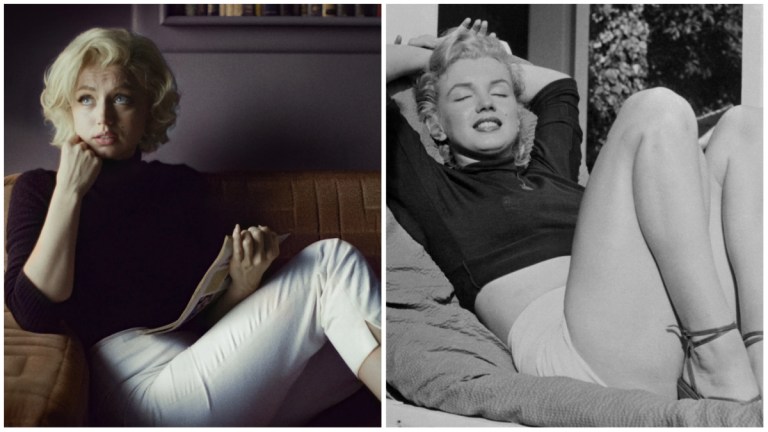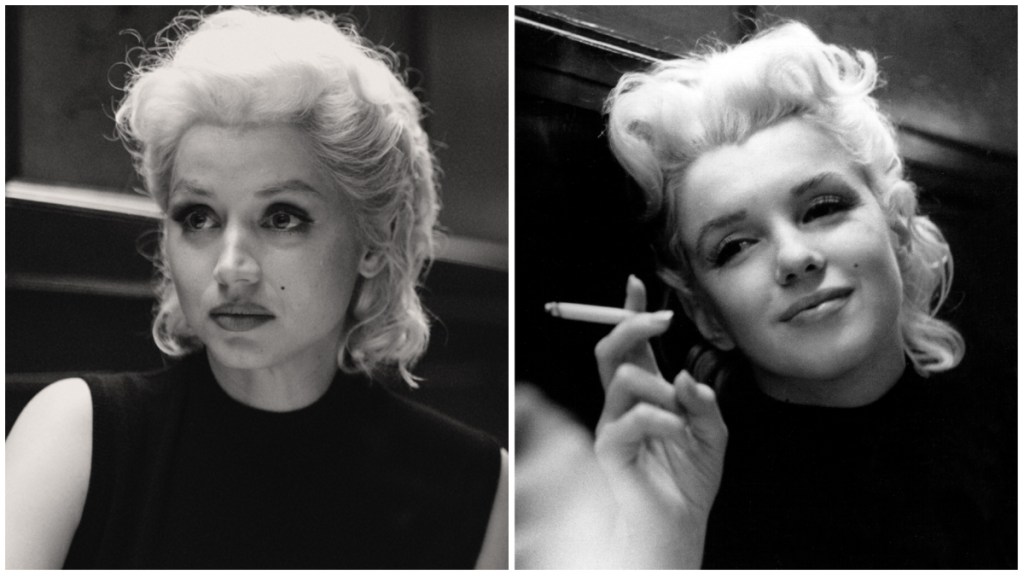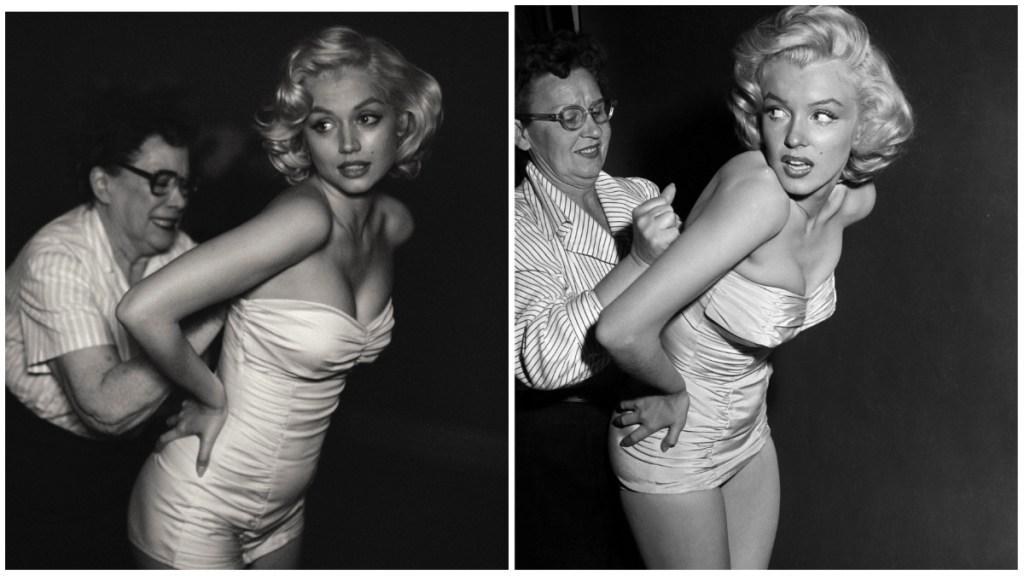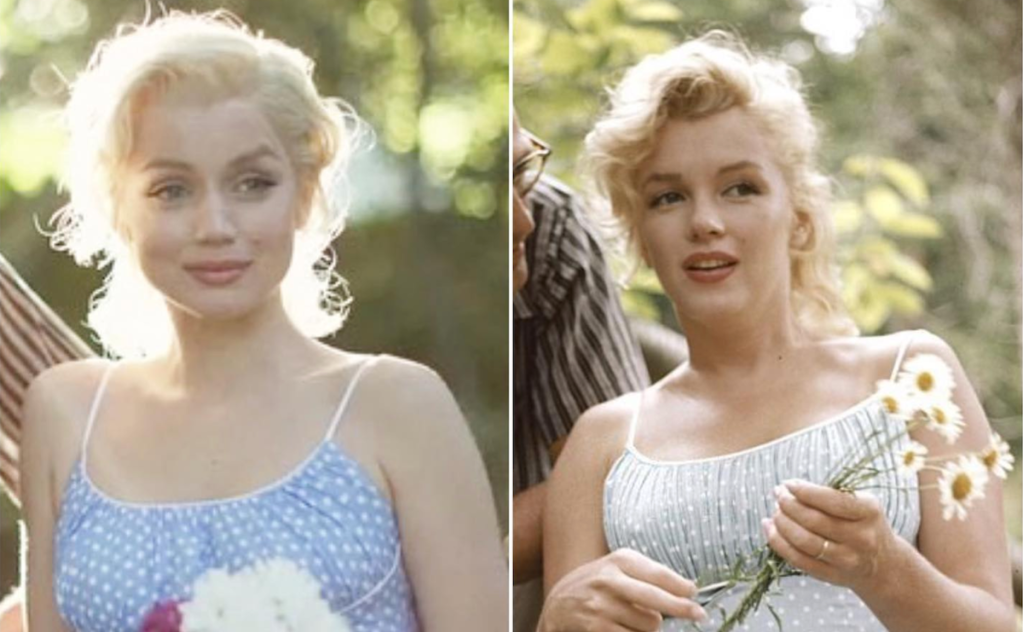Blonde and Marilyn Monroe’s True History: How Much Really Happened?
Andrew Dominik and Netflix’s Blonde makes some controversial choices while telling the life story of Marilyn Monroe.

This article contains lots of Blonde spoilers.
When Joyce Carol Oates began writing Blonde, the 2000 novel on which the new Ana de Armas movie is based, she admitted she was less concerned with the facts of Marilyn Monroe’s life than the idea of the quintessential movie star. Oates saw Monroe as an emblem of 20th century America, a pivotal intersection of the nation’s values and fantasies about sex, power, and the role of women during a moment of cultural ascendence.
This also means that much of the work is fictionalized—which is a polite way to say made up. These details have lingered on the page where the clarity of Oates’ vision, and the persuasiveness of her prose, made Blonde a seminal work that was instantly recognized as a finalist for the Pulitzer Prize and National Book Award. However, those who’ve only read Oates’ novel might come away with a very different perception of Norma Jeane Mortenson, the woman who would become Marilyn Monroe, than what the historical record suggests.
That line is about to be blurred much further with the release of Andrew Dominik’s movie adaptation of Oates’ novel. Immaculately crafted and deliberately opaque, the film provides a meditative and seemingly biographical portrait of Monroe’s life, with de Armas playing Monroe as both a fragile, wounded creature and an often hysterical, oversexed pawn who ran away from her natural desire to build a family.
Whether Netflix’s Blonde is an artistic success is open to interpretation, but below are some of the most shocking and scintillating revelations in the movie—and how they stack up against the facts of Monroe’s life.
Did Marilyn Monroe’s Mother Try to Drown Her in a Bathtub?
The real Norma Jeane Mortenson, born in 1926, came from a long lineage of mental illness. This is dramatized to viscerally horrifying effect in Blonde when as a child Norma Jeane is repeatedly beaten by and terrified of her single mother Gladys Pearl Baker (Julianne Nicholson). Eventually, on the night of a Hollywood fire, Gladys has a breakdown and tries to drown her daughter in the bath. Norma Jeane barely escapes her nude mother by running to her neighbors across the hall, Albert Wayne and Ida Bolender.
It’s the stuff of a horror movie—it also is a disservice to the real Gladys because Marilyn never claimed her mother tried to drown her. Blonde as both a novel and film conflates Gladys with her own mother, Norma Jeane’s grandmother Della Monroe. Like her daughter and (probably) her granddaughter, Della struggled with bouts of mental illness and depression. Marilyn later told a journalist that her first memory was of a smothering sensation when Della placed a pillow (or something similar) over her face while the child was sleeping. Marilyn’s third husband Arthur Miller later confirmed to biographer Fred Lawrence Guiles that Marilyn shared this story with him.
At the time, Marilyn would’ve been less than two years old when this occurred, but perhaps the trauma left a striking memory, as did what came later. One morning when as a young girl Norma Jeane was visiting her neighbors across the street, the real-life Bolenders, they began hearing banging on the door. It was Della, demanding Norma Jeane come back. She paced up and down their porch and banged the door so hard she broke a pane and cut her hand. The Bolenders called a police car, and Della was dragged away screaming.
Della Monroe was committed to the Norwalk State Hospital you see in Blonde where she died 18 days later of a seizure.

Did Marilyn Monroe’s Mother Keep a Framed Picture of the Missing Father on the Wall?
In Blonde, the image of Norma Jeane’s father is presented as something like the Rosebud sled in Citizen Kane. Her mother uses the photograph to brainwash Norma Jeane into believing that one day daddy will return and save them from their life of squalor.
In reality, the childhood of Norma Jeane was incredibly unstable, veering from some sense of normalcy, such as in one home where her mother bought a baby grand piano that Marilyn would hunt down later in life after it had been sold, to Gladys boarding Norma Jeane with the aforementioned Bolenders for several years while sending a monthly stipend for her daughter’s care.
Sadly, like her mother, Gladys struggled with depression and mental disorders, and was eventually committed to the same hospital where her mother died. However, unlike in the movie Blonde, Gladys did not die there, completely incapable of even recognizing her daughter. It’s actually because of Gladys, and not the Bolenders who are depicted onscreen as not wanting to get involved, that Marilyn ended up in an orphanage. After Gladys was committed, Norma Jeane eventually came to be in the care of a family who wanted to adopt the child and move to New Orleans. Gladys refused, as she did not want to lose her daughter, so Norma Jeane was institutionalized at an orphanage and, eventually, a series of foster homes.
Still, before she was committed, Gladys kept a picture of a man on her wall and told Norma Jeane it was her father: the photo was of Charles Stanley Gifford. What Blonde does not get into is that Gifford was not Gladys’ first husband—with whom she actually had several children before Norma Jeane. Married to an older man named Jasper Newton Baker when she was 15, Gladys met Gifford while working as a film cutter at Consolidated Film Industries in Los Angeles. Gifford reportedly showed no interest in helping raise a kid after Gladys told him she was pregnant—Jasper meanwhile left her and took their children out of state.
As a child, Norma Jeane would later tell her peers that her father was Clark Gable, who somewhat resembled Gifford and would later star opposite Monroe in the final film for both actors: The Misfits (1961).
For the record, Gladys first left her mental hospital after more than a decade of care there. She stayed with Norma Jeane in an apartment during World War II, although Norma notably moved to a studio club for ingenues to get away from seeing her mother everyday. Out of loneliness, Gladys eventually asked to be recommitted and would be in and out of hospitals for the rest of her life.
Was Marilyn Monroe Catfished by Forged Letters from Her “Tearful Father?”
It is a complete invention on the part of Oates and Dominik that after becoming a movie star, Marilyn Monroe forged a decades-long correspondence with a man claiming to be her “tearful father” (more on that below). While she was obviously haunted by his absence and did call some of her lovers “daddy” as a term of affection—which is open to all sorts of psychoanalysis—she was never so infantilized as to be manipulated by a stranger into madness.
In fact, the real Marilyn made an effort to meet with Charlie Stanley Gifford in the 1950s. In Fred Lawrence Guiles’ trenchant biography Norma Jean, the author related a story told to him by Natasha Lytess, one of Marilyn’s earliest confidants and mentors whom she met when Lytess was the chief drama coach at Columbia Pictures (like most of Marilyn’s friends and mentors, however, there would eventually be a falling out).
Natasha told of accompanying Marilyn on an impulsive drive into the California countryside. At this point, Marilyn had become successful enough as an actress to hire a private eye to hunt Gifford down. Her father had been married several times since leaving her mother. He was now the successful owner of a dairy farm business. One morning, Marilyn decided she’d drive to his Red Rock Dairy farm and confront him face-to-face and wanted Natasha there for support. But on the drive up, she grew cold feet and decided to call in advance.
Parking at a gas station, Marilyn used a payphone, and according to Natasha said, “It’s Marilyn, his little girl. Gladys Baker’s daughter.” It turned out a woman, likely Gifford’s third wife, picked up the phone. Natasha recalled Marilyn holding her breath and closing her eyes waiting to hear his voice. The woman on the other end eventually came back and said, “He doesn’t want to see you.” Marilyn was advised to reach out to his lawyer for further contact.

Was Marilyn Monroe Raped on a Casting Couch?
There are no official reports or stories about Marilyn being raped while beginning her career, or that she was forced onto a casting couch. However, she was molested by a foster father.
In episodes entirely absent from Blonde, Marilyn spent her final years of adolescence—at least while single—staying with foster parents Grace and Erwin “Doc” Goddard. Grace had been a friend of Gladys and agreed to raise Norma Jeane with her own daughter after Norma Jeane had spent years in an orphanage and in and out of foster homes.
It was also Grace who rushed Marilyn into marriage at age 15 with a neighborhood boy who was 21, Jim Dougherty. Her first marriage is skipped in Blonde, but one reason for its impetus is likely what Grace saw going on in her own house. Norma Jeane later told Jim that when she was 15, Doc came into her bedroom one night while drunk and stuck his tongue down her throat. She was mortified but afterward acted like nothing had happened and continued to call Doc “daddy” until she was wedded out of the house. As a struggling actress in the late 1940s, she also was almost raped by an off-duty cop who followed her home one night and cut a hole through the screen door of the Burbank home she was housesitting in. Her screams woke neighbors and led to a police report.
As for the older men in her life in Hollywood, she did have affairs with two powerful men while starting out: first there was former 20th Century Fox chairman Joseph M. Schenk, and later talent agent Johnny Hyde, who was vice president of the William Morris Agency. They were both older with the power dynamics woefully imbalanced, although neither relationship could be seen as purely transactional. Her affair with Schenk was viewed as self-detrimental on the Fox lot since Schenk was “damaged goods” after taking the fall for the studio bribing union teamsters (like every other studio) and serving a prison sentence. It also made Fox head Darryl Zanuck jealous as he likely wanted to sleep with the new ingenue.
Meanwhile Hyde—who is seen in Blonde as her first industry “daddy” accompanying Marilyn to the premiere of All About Eve—helped her career, including by pushing for her to be auditioned for Eve. But he also proposed marriage to her, and she declined. When Hyde died of a heart attack, she attended his funeral (against the wishes of his family, including the wife he divorced for Marilyn) and screamed “Johnny” over the coffin to the horror of Hyde’s family. According to Natasha Lytess, she found Marilyn later that night passed out from her first suicide attempt with sleeping pills.
Was Marilyn Monroe in a Throuple with the Sons of Charlie Chaplin and Edward G. Robinson?
No, there is no historical record of Marilyn Monroe in a three-way relationship, much less to the point where it was becoming industry gossip as suggested by Johnny Hyde in Blonde. The creation of Cass (Xavier Samuel) and Eddy (Evan Williams) as two doppelgängers of temptation that would ultimately destroy Monroe, at least in Cass’ case, is entirely Oates’ invention—although the real Charlie Chaplin Jr. (who outlived Marilyn Monroe, unlike Cass in Blonde) did erroneously claim in his memoirs to have had an affair with Monroe in 1947. Even so, it doesn’t match the facts or what’s depicted in Blonde.
But I suppose in the movie, Cass and Eddie represent the insidious side of the patriarchy by impersonating her male father figure and using that as a form of control and eventual destruction…
Did Marilyn Monroe Have an Abortion in the ‘50s She Later Regretted?
No. Although there is some debate whether she had an abortion shortly before her death in 1962 (more on that below).
Marilyn Monroe’s Marriage to Joe DiMaggio
In pop culture, Joe DiMaggio is remembered as the great love of Marilyn Monroe’s life. He’s the former all-American baseball player who kept the flame alive in the press after (in his opinion) the Kennedys drove her to an early grave. So it’s probably shocking to see him depicted by Bobby Cannavale in Blonde as a neolithic hothead who just wanted Marilyn in the kitchen and calling him “daddy”—and when she didn’t he’d beat her senseless.
However, in this case, Blonde is closer to the truth than the popular mythology. While she did not agree to marry DiMaggio on a whim after being catfished yet again by her “tearful father,” she did struggle with the decision to marry DiMaggio in real life. In reality, Marilyn was more prone to call him “my slugger” than “daddy,” but there was friction when they were dating, with DiMaggio referring to the Hollywood folk around his new girlfriend as “phonies” and “leeches,” and her not entirely disagreeing when Natasha Lytess suggested Joe never read cover to cover one book on his shelf. (Something Blonde glosses over is Marilyn was a voracious reader.)
Later in life, Marilyn said when they were dating that they avoided talking about anything of substance, and she kicked him out of her apartment at least once—possibly because the first act of violence occurred then. Whatever the case, he first proposed marriage in November 1953, and she did not agree to marry him until Jan. 12, 1954. They were wedded two days later in a small ceremony.
According to Natasha, who was pushed out of Marilyn’s inner-circle around this time, their evenings were “dire” with Joe watching sports on television and generally ignoring Marilyn who read script lines. DiMaggio did not want Marilyn to work, especially in roles like The Seven Year Itch (1955).
The first time Joe gets violent in Blonde is because Cass Chaplin attempts to blackmail him with photographs of a nude calendar photoshoot Marilyn did before she was famous. This is fiction. A blackmailer tried to use those photos before their marriage against RKO Pictures, which had a Monroe movie ready to release. So RKO shared the photos themselves on the wire service, although Monroe later claimed it helped her garner sympathy from audiences when she explained she took those photos because she didn’t have enough money to eat or pay for a car that had been repossessed.
The second depiction of domestic abuse in Blonde is accurate. While shooting the famous “subway grate” sequence in The Seven Year Itch on Lexington Avenue, DiMaggio was really there along with the press. The latter reported DiMaggio was either despondent or seething with his hands in his pockets while he watched his wife. He eventually left in disgust, returning to their suite at the St. Regis Hotel.
Later that night guests staying on the same floor as DiMaggio and Monroe, and below them, reported to the front desk that they heard screaming, scuffling, and then a woman weeping. Joe left the next morning without her, their marriage ended shortly thereafter. While they became pen pals later in life before Marilyn’s suicide, and he wrote clearly with the hope of rekindling their romance, it never stuck.
One of Monroe’s publicists told biographer Guiles, “Joe wasn’t any great hero in Marilyn’s life. He was vicious. He couldn’t have treated her worse. He beat the hell out of her and she was terrified. He continued bothering her months after their divorce. It seems nice and considerate not to talk to anybody because of his precious memories, but he was rotten to her. I’m not sure how they got back as friends near the end… I know their friendship was blown out of all proportion by the newspapers.”

Marilyn Monroe’s Marriage to Arthur Miller
Few folks are aware that Marilyn Monroe began courting playwright Arthur Miller ever before meeting Joe DiMaggio. Blonde also glosses over that fact, but it’s right to show that he was a bit skeptical about meeting her at first. He then was surprised, and fascinated, by her mind. They became pen pals afterward, although Miller distanced himself when Marilyn wrote she dreamed of moving to Brooklyn (where he lived with his then-wife and children).
They reconnected after each of their marriages fell apart, and many biographers argue, as does Blonde, that Miller was the love of Monroe’s life. He engaged with her intellectually and attempted to nurse her anxieties and insecurities—until he could not. The truth is they were happier while dating and forming a united front while he faced Contempt of Congress charges for refusing to name names to HUAC. Afterward, they quickly wed.
Their first road bump occurred while Miller accompanied Monroe as she was filming The Prince and the Showgirl (1957) in England with Sir Laurence Olivier. Olivier and Monroe did not get on at all, and Miller was often forced to act as mediator. Six weeks into this process, Marilyn discovered Arthur’s personal notebook/journal left open next to her script, in which Miller admitted to his frustration and disappointment in Marilyn on the film. According to famed acting teachers Lee and Paula Strasberg—who by this time had become Marilyn’s acting coaches and something close to cult-like leaders in her life—Marilyn was so distraught they needed to rush her to a psychiatrist at once. Lee insists this was the beginning of the end of the Miller marriage.
In Blonde, this is re-contextualized as Marilyn discovering Arthur (Adrien Brody) has written about their marriage in one of his scripts. This is based on the popular assumption that Miller used Monroe for artistic inspiration while writing The Misfits and his 1964 play After the Fall. While there is truth in that, he began The Misfits before he and Marilyn were fully dating and had her tacit approval (maybe) over that far more flattering portrait than After the Fall, which was finished after Monroe’s death.
Either way, it is true they struggled to have children. In Blonde, Miller is implicitly blamed by Monroe as she has her miscarriage because Arthur forces her to entertain his friends on a beach where she trips and falls. In reality, the first loss of a child occurred when Marilyn became ill and she was diagnosed to have an ectopic pregnancy. To save her life, she was forced to terminate the pregnancy. The second time occurred while she was filming Some Like It Hot (1959), which created a riff between Miller and director Billy Wilder since Arthur blamed Wilder for Marilyn’s miscarriage.
Reports suggest that for the first several years, Arthur fawned over Marilyn. However, he grew weary of her need for constant reassurances, and her eventually carrying on an affair with Yves Montand didn’t help matters. They divorced in 1961, one year before her death.

Was Marilyn Monroe Really That Difficult to Work with on Some Like It Hot?
While Blonde perhaps focuses too much on Marilyn’s volatility and insecurities in her later years, and only shows her on set at her lowest moments—either as a prelude to DiMaggio beating her or when she is being “difficult”—there is truth that by her final films, she had become increasingly unreliable.
Billy Wilder recalled one episode of the Some Like It Hot shoot where Marilyn kept the whole production waiting more than two hours while reading a book that Arthur recommended to her in her dressing room. When a young assistant was asked to knock on her door, she shouted, “Why don’t you go fuck yourself?” Meanwhile the director of Bus Stop (1956) loaded his cameras with up to an hour of film reels and kept them rolling while he attempted to coax a performance out of Monroe, who became hostile to the filmmaker after a disagreement over her performance in the dailies.
Shortly after Some Like It Hot was finished, co-star Tony Curtis likened making out with Monroe for the film to “kissing Hitler.” He later became more gentle in his recollections of Marilyn after her death.
Marilyn Monroe and the Kennedys
Perhaps the most shocking scene in all of Blonde is when she is brought in to meet President John F. Kennedy—her inner-monologue rightly surmises it’s like a piece of meat being delivered—and he immediately forces her to perform oral sex on her. In extreme close-up, we study her eyes as she considers this surreal and nightmarish situation of being debased to the point of a concubine by the president.
From what we know, she likely did act as Kennedy’s mistress and paramour, and if so did it out of a sense of admiration for the young POTUS. What went on behind closed doors—and whether he physically abused and demeaned Monroe—is pure conjecture and speculation by Blonde.
With that said, Marilyn might’ve slept with JFK, but the Kennedy she obsessed over was his younger brother and the attorney general Robert Kennedy. She visited Bobby repeatedly and made multiple calls to the Justice Department, some of which were logged by Bobby’s personal secretary. Marilyn even told a friend she was considering marrying for a fourth time, perhaps someone in politics and who lived in Washington D.C. This would seem to suggest she became infatuated with Bobby, because it would surely be delusion to think he’d torpedo his marriage and political career to marry a (thrice divorced) movie star.
There is also some contention whether Monroe had an abortion around this time. A publicist who worked with Marilyn’s press agent claims she had an abortion several weeks before her suicide, with biographers speculating it could’ve been either John or Bobby Kennedy’s unborn child.
Some also speculate that Marilyn even saw Bobby during the last few days of her life. Robert Kennedy was in California when she died, arriving at a small ranch 85 miles south of San Francisco the day before. The Justice Department document that records this has been noted as unusual since it details his arrival on a day when nothing else of official government business was scheduled or recorded. It simply states he spent the first two nights at the ranch before staying at a friend’s apartment in the city on Sunday evening. It’s miscellaneous, but conspiracy theorists will be quick to note it sure is handy as evidence he was nowhere near Los Angeles on the last weekend of Marilyn Monroe’s life.
Did Marilyn Monroe Kill Herself Because of Her Father?
As aforementioned, she was never actually catfished by a made-up son of Charlie Chaplin into believing she was having a profound correspondence with her “tearful father.” The real Charlie Chaplin Jr. did not even die before her—and therefore did not bequeath evidence that he manipulated her all these years because he’s some kind of cruel, evil fiend.
The truth is we’ll never know exactly why Marilyn killed herself other than she suffered from bouts of depression and loneliness, the kind which Arthur Miller has discussed at length of witnessing and trying to help her fight. Whether Bobby Kennedy ended things with her the day before or if she just had another empty weekend in her increasingly isolated lifestyle, perhaps also reflecting on her then dimming career since she’d also just been fired by Fox off a movie called Something’s Gotta Give, is anyone’s guess.
All that is certain is Marilyn Monroe, the woman who was born Norma Jeane, died of an overdose of sleeping pills on Aug. 4, 1962. She was only 36.
